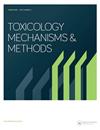氯气的毒性作用和潜在的治疗方法:文献综述
IF 2.8
4区 医学
Q2 TOXICOLOGY
引用次数: 25
摘要
氯气是美国和世界上产量最高的化学品之一。氯气在水净化、卫生和工业应用中有几种用途;然而,它是一种有毒的吸入危险剂。根据接触氯气的浓度和持续时间,吸入氯气会引起一系列症状,包括但不限于流泪、鼻流、支气管痉挛、咳嗽、呼吸困难、急性肺损伤、死亡,幸存者会出现肺纤维化和反应性气道疾病的迹象。尽管自第一次世界大战以来,氯气就被用作化学战剂,而且众所周知,氯气可能对工业造成危害,但目前还没有专门的解毒剂。近年来,氯气作为化学战剂的重新使用引发了人们对其用作大规模杀伤性武器的猜测。因此,开发氯气引起的肺损伤的解毒剂仍然是当务之急。虽然一些临床前研究在了解氯气诱导的肺部病理生理和确定潜在的医疗对策方面取得了实质性进展,但没有一种候选药物获得美国食品和药物管理局(FDA)的批准。本文综述了氯气致肺损伤的病理生理学、临床前动物模型、FDA动物法规下潜在医学对策的发展以及氯气致肺损伤解毒剂的未来发展方向。本文章由计算机程序翻译,如有差异,请以英文原文为准。
Toxic effects of chlorine gas and potential treatments: a literature review
Abstract Chlorine gas is one of the highly produced chemicals in the USA and around the world. Chlorine gas has several uses in water purification, sanitation, and industrial applications; however, it is a toxic inhalation hazard agent. Inhalation of chlorine gas, based on the concentration and duration of the exposure, causes a spectrum of symptoms, including but not limited to lacrimation, rhinorrhea, bronchospasm, cough, dyspnea, acute lung injury, death, and survivors develop signs of pulmonary fibrosis and reactive airway disease. Despite the use of chlorine gas as a chemical warfare agent since World War I and its known potential as an industrial hazard, there is no specific antidote. The resurgence of the use of chlorine gas as a chemical warfare agent in recent years has brought speculation of its use as weapons of mass destruction. Therefore, developing antidotes for chlorine gas-induced lung injuries remains the need of the hour. While some of the pre-clinical studies have made substantial progress in the understanding of chlorine gas-induced pulmonary pathophysiology and identifying potential medical countermeasure(s), yet none of the drug candidates are approved by the U.S. Food and Drug Administration (FDA). In this review, we summarized pathophysiology of chlorine gas-induced pulmonary injuries, pre-clinical animal models, development of a pipeline of potential medical countermeasures under FDA animal rule, and future directions for the development of antidotes for chlorine gas-induced lung injuries.
求助全文
通过发布文献求助,成功后即可免费获取论文全文。
去求助
来源期刊

Toxicology Mechanisms and Methods
TOXICOLOGY-
自引率
3.10%
发文量
66
期刊介绍:
Toxicology Mechanisms and Methods is a peer-reviewed journal whose aim is twofold. Firstly, the journal contains original research on subjects dealing with the mechanisms by which foreign chemicals cause toxic tissue injury. Chemical substances of interest include industrial compounds, environmental pollutants, hazardous wastes, drugs, pesticides, and chemical warfare agents. The scope of the journal spans from molecular and cellular mechanisms of action to the consideration of mechanistic evidence in establishing regulatory policy.
Secondly, the journal addresses aspects of the development, validation, and application of new and existing laboratory methods, techniques, and equipment. A variety of research methods are discussed, including:
In vivo studies with standard and alternative species
In vitro studies and alternative methodologies
Molecular, biochemical, and cellular techniques
Pharmacokinetics and pharmacodynamics
Mathematical modeling and computer programs
Forensic analyses
Risk assessment
Data collection and analysis.
 求助内容:
求助内容: 应助结果提醒方式:
应助结果提醒方式:


